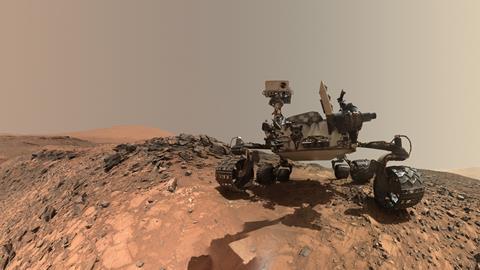Ben Valsler
This week, Brian Clegg brings us a super semiconductor.
Brian Clegg
Gallium and arsenic are the kind of mid-ranking elements – at atomic numbers 31 and 33 – that are easy to forget (unless you want to poison someone). But combine them in the compound gallium arsenide and you get a material that is an electronic powerhouse. This dark grey crystal takes on the ubiquitous dominator of the microchip world, silicon – and, at the quality end of the market, wins hands down.

Silicon has proved its worth as a semiconductor over and over. It’s a cheap and cheerful solution as the raw material is, when it comes down to it, sand. By contrast, gallium arsenide is costly – it’s not unusual for gallium arsenide wafers to cost a thousand times more than the silicon equivalent – but the compound makes up for that expense in high performance results. It’s the supercar to silicon’s mass-market hatchback.
One of the key differences between gallium arsenide and silicon is in the nature of its band gap. This is a no-go zone between the ‘valence band’ – which is the outer layer of electrons on an atom responsible for its chemical properties – and the ‘conduction band’: the first empty set of states excited electrons can move to. In semiconductors, the band gap is just the right size that electrons don’t easily cross it, but can be boosted across to conduct electricity under the right stimulation.
Gallium arsenide has what’s known as a direct band gap, meaning an incoming photon can push an electron across it, while silicon has an indirect band gap, which requires more help to get the electron in motion. The result is that, for example, gallium arsenide photovoltaic cells – solar panels – absorb light significantly better than silicon cells. Not only are they more efficient, but they can be much thinner, as a photon has to travel far further through a silicon-based cell before it has an effect.

The result is that gallium arsenide has, from the early days, been a favoured material for the essential solar cells that give power to spacecraft. The first uses were in early satellites from the USSR, starting with the Venera 3 probe. This was dispatched to Venus in 1965, though sadly lost communications before it could send information from the surface.
Despite the shaky start, gallium arsenide cells were used on a number of early Soviet missions, and by the 1990s variants dominated space applications, including Nasa’s Mars Rovers. That considerable delay from the first Soviet use to ubiquity was in part due to the need to find a suitable substrate. Gallium arsenide is so efficient that there is no need to have anything more than a thin film of it, but it took a considerable time to find a way to grow these films reliably on a supporting layer of another material.

As well as being efficient, gallium arsenide cells are also far better at standing up to radiation than silicon equivalents – essential when operating in space. Because the gallium arsenide layer is significantly thinner, high energy particles such as protons are more likely to pass straight through without causing damage. Back on Earth, in specialist ultra-light cars powered by solar cells, gallium arsenide is the go-to substance, remaining at the top end of the efficiency and thinness charts. This is emphasised by a 2019 development at the Centre for Nanoscience and Nanotechnology in Paris. Operating at a similar efficiency to a silicon solar cell, where such a cell would be 40 micrometres thick, the new material was just one fifth of a micrometre thick – 200 times thinner than the silicon.
Gallium arsenide’s absorption and emission of light extends beyond the visible, with the compound turning up in specialist infrared lasers and microwave circuits. The first GPS receivers developed by the US Defense Advanced Research Projects Agency had gallium arsenide circuitry. Some of the earliest uses arose from the development of the Gunn diode, a device originating from John Gunn’s 1962 work on the compound. The diode is used in microwave frequency oscillators, for example in radar speed guns and in radio telescopes. Most ubiquitously, despite its cost, you will almost certainly have a gallium arsenide device in your pocket. Because of its efficiency, ability to handle high frequency signals better than silicon and low circuit noise levels, gallium arsenide is deployed in the power amplifiers of most mobile phones.
Cellphones apart, gallium arsenide rarely makes it into the mass market. Silicon is too cheap, readily available and easy to manufacture. Nonetheless, gallium arsenide remains the ultimate solar cell material. If money is no object, gallium arsenide is the Bugatti Chiron of optical semiconductors.
Ben Valsler
Brian Clegg with gallium arsenide. Next week, another versatile fragrance molecule, with Louise Crane.
Louise Crane
Beta-damascenone is a major contributor to the aroma of roses, though you’ll also find it popping up in the smell of Kentucky bourbon, so if the roses don’t work, then you can at least drown your sorrows.
Ben Valsler
Join Louise next time. Until then, we’d like to hear your suggestions for compounds to cover – email chemistryworld@rsc.org or tweet @chemistryworld. I’m Ben Valsler, thanks for listening.













No comments yet